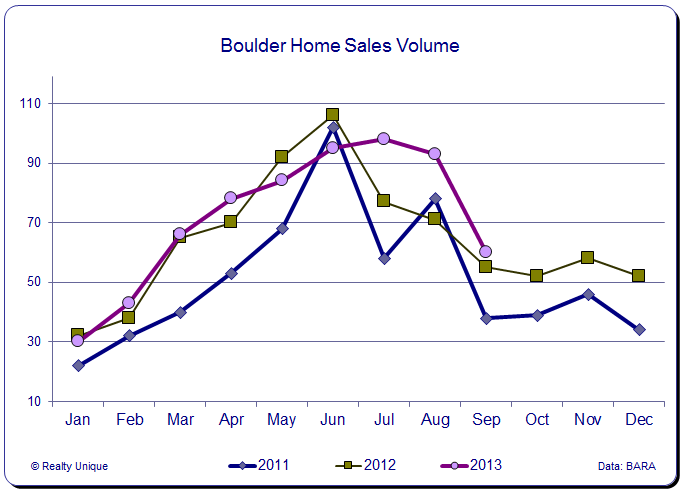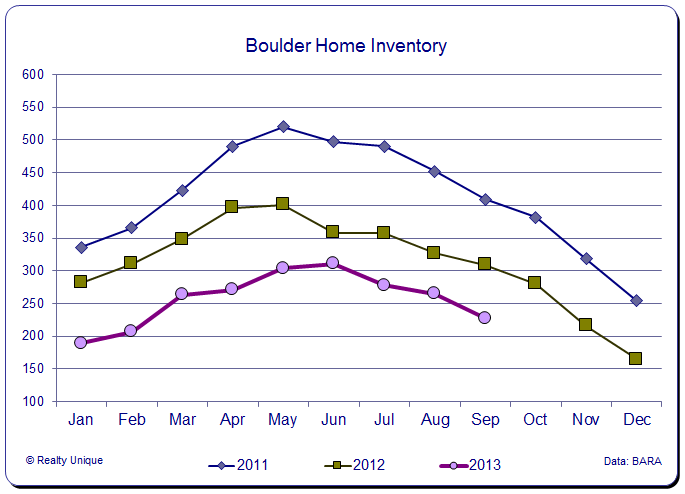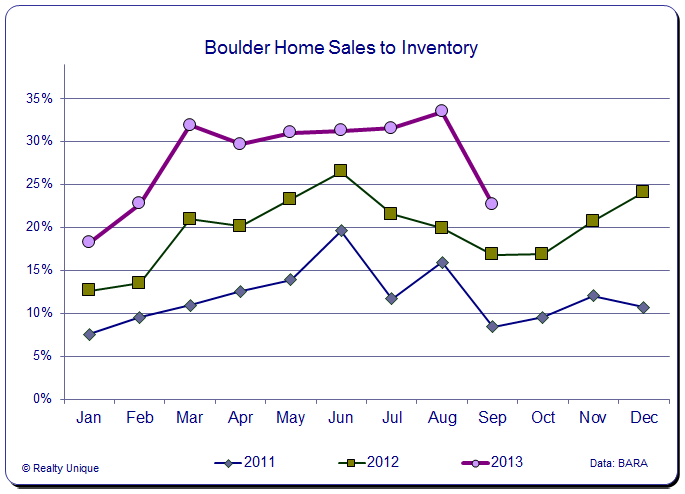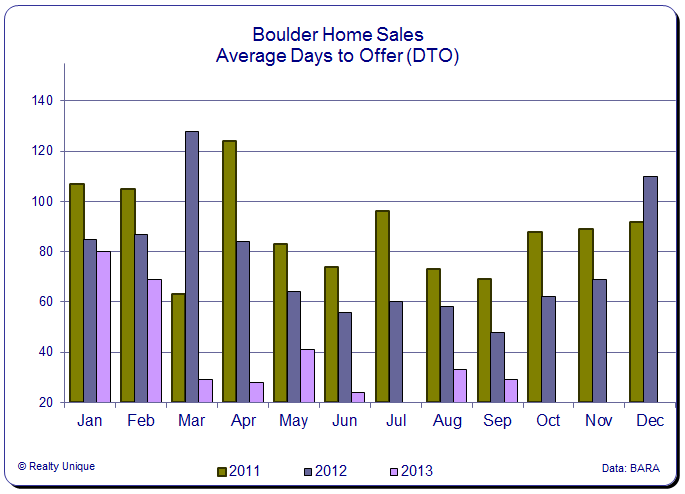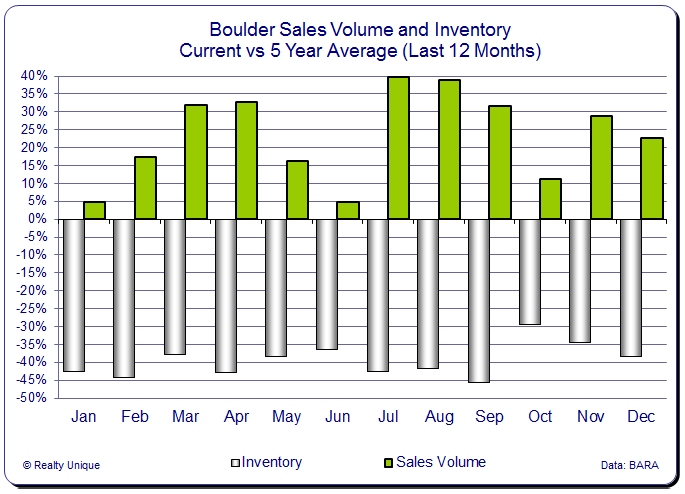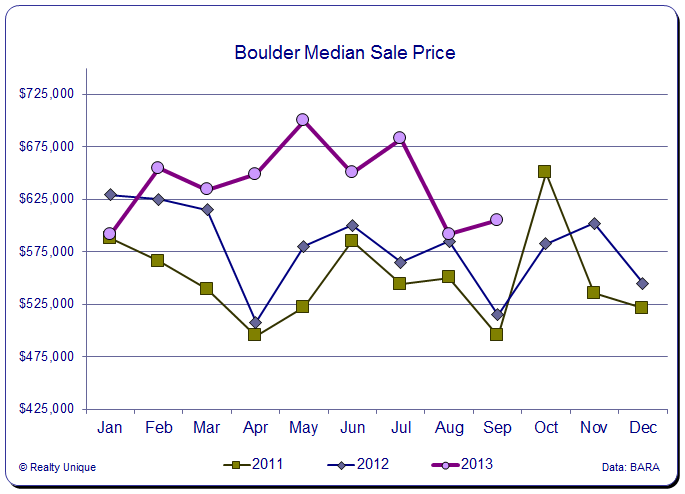Historic Floods Can’t Drown Boulder Real Estate Market [Market Update]
by Osman Parvez
Many of you have been asking about the impact of last month’s historic flood on the Boulder real estate market. Let’s look at the numbers.
Boulder Real Estate Market Update
The following analysis is for traditional single family houses, only. I’ll publish an analysis for town homes and condos in another post.
Just a reminder… I’m a Realtor. My goal is to help you make a smarter decision. If you’re in the market to buy, or you’re thinking about selling, give me a call. 303.746.6896.
Boulder Home Sales Volume
The chart above shows sales volume by month for the past few years. The Boulder real estate market follows a seasonal pattern. Volume typically peaks in June and reaches the bottom in January.
This year, all three summer months experienced very strong sales volume. Market activity peaked in July. September saw a strong decline, bringing closings more in line with the past few years.
60 houses closed during September, about 9% above last year and down a steep 36% from the previous month. Volume remained 32% above the five year average for September.
Boulder Home Inventory
227 houses were available for purchase during September, 27% below last year and a decline of 14% from the previous month. As you can see from the chart, the inventory shortage which began at the end of 2011 continues unabated. Sorry buyers, selection still sucks is still limited.
Boulder Home Absorption
Absorption is the relationship between inventory and sales volume. It’s a measure of liquidity and a quick glance at the relationship between supply and demand for Boulder homes.
Already at record highs, the absorption rate was stable and continuing to climb for the four month period prior to the September floods. September absorption fell dramatically to 22.6%, a massive decline from August’s 33.5%.
Make no mistake, 22.6% is still very high. It’s actually more than double the five year average absorption for September.
Boulder Homes Days to Offer
This chart shows the average days to offer for properties that closed during the month. Don’t forget, most closings occur 30-45 days after the seller accepts an offer.
I had to double check my analysis because, as you can see, there is no 2013 DTO for July. That’s because DTO fell to 18, below the axis minimum in the chart. It’s a new monthly record going back at least a decade (when I started tracking).
As my clients will confirm, buying a house this summer was very challenging. New listings created a frenzy and an emergency response. We had to see the property the same day, if possible. Waiting a few days would likely result in missing the opportunity to submit an offer. Not letting the property stay available to all potential buyers for at least a week wasn’t usually in the best interest of the seller by the way. But that’s another topic.
For closings which occurred during September, the average days to offer was 29 – about half of the long term average for the month.
Sales and Inventory vs. the 5 Year Average
This chart shows the relative behavior of sales volume and inventory to their respective monthly averages. For the past twelve moths, sales volume (green) has consistently been well above average. Meanwhile inventory (white) has consistently been below average.
When someone waves their arms around and says, “the market is crazy only because of low inventory,” you can tell them confidently that sales volume is actually up despite the lack of selection. It’s also a long term trend, not a monthly aberration. This is a very strong indicator for upward price movement.
Boulder Median Sale Price
People often get confused about the chart above, so I’ll say it right up front. The chart above does not show appreciation or depreciation. It’s not an indicator of price movement.
The chart above shows the median selling price during the month. It’s an indicator of what price point is selling. The median sale price during September was $604,950.
p.s. I hate this chart. I only include it because readers always ask for it.
Conclusions
As I wrote in my last post, 33% of inventory is under contract (i.e pending sales). This remains a high number for this time of year. I suspect the floods caused a small portion of closings to be delayed but the majority have (or will) close on time.
Closings lag 30-45 days, so the full impact of flooding won’t show up until October’s data is released in early November. When that report is issued, it will likely show the market cooled somewhat but remains overheated.
The greater risk factor to market activity continuing at a torrid pace is an increase in borrowing costs. And by the way, it’s not IF, it’s WHEN.
As of this writing, the government shut down continues. This potentially limits the Fed’s bond buying activity sooner than markets expected. At some point, Fannie and Freddie are going to slow packing your mortgages into securitizations because there are few buyers. When that happens, it will move rates upward overnight because that is what it will take to get those bonds sold. It won’t be a pretty picture for weaker real estate markets but for Boulder, I suspect the impact will pull us closer to a healthy balance between buyers and sellers.
Where The Rubber Meets the Road
You’re probably not buying securitized mortgage bonds, so lets talk about active and potential buyers and sellers. If that’s YOU, my advice is to plan around your personal needs. If you’re looking at 3 years of renting (or more), in most cases you’d probably be better off buying. If you’re thinking about selling, the market really has never been better. Prices will likely be higher in the future, but there is risk in waiting for prices to rise. If your house is somewhat less than spectacular in condition, I’d recommend putting it on the market sooner.
As always, I’m available for a confidential consultation on your real estate situation. To discuss strategy for your specific real estate situation, give me a call. 303.746.6896.
—
Historic Floods Can’t Drown Boulder Real Estate Market [Market Update]
by Osman Parvez
Many of you have been asking about the impact of last month’s historic flood on the Boulder real estate market. Let’s look at the numbers.
Boulder Real Estate Market Update
The following analysis is for traditional single family houses, only. I’ll publish an analysis for town homes and condos in another post.
Just a reminder… I’m a Realtor. My goal is to help you make a smarter decision. If you’re in the market to buy, or you’re thinking about selling, give me a call. 303.746.6896.
Boulder Home Sales Volume
The chart above shows sales volume by month for the past few years. The Boulder real estate market follows a seasonal pattern. Volume typically peaks in June and reaches the bottom in January.
This year, all three summer months experienced very strong sales volume. Market activity peaked in July. September saw a strong decline, bringing closings more in line with the past few years.
60 houses closed during September, about 9% above last year and down a steep 36% from the previous month. Volume remained 32% above the five year average for September.
Boulder Home Inventory
227 houses were available for purchase during September, 27% below last year and a decline of 14% from the previous month. As you can see from the chart, the inventory shortage which began at the end of 2011 continues unabated. Sorry buyers, selection still sucks is still limited.
Boulder Home Absorption
Absorption is the relationship between inventory and sales volume. It’s a measure of liquidity and a quick glance at the relationship between supply and demand for Boulder homes.
Already at record highs, the absorption rate was stable and continuing to climb for the four month period prior to the September floods. September absorption fell dramatically to 22.6%, a massive decline from August’s 33.5%.
Make no mistake, 22.6% is still very high. It’s actually more than double the five year average absorption for September.
Boulder Homes Days to Offer
This chart shows the average days to offer for properties that closed during the month. Don’t forget, most closings occur 30-45 days after the seller accepts an offer.
I had to double check my analysis because, as you can see, there is no 2013 DTO for July. That’s because DTO fell to 18, below the axis minimum in the chart. It’s a new monthly record going back at least a decade (when I started tracking).
As my clients will confirm, buying a house this summer was very challenging. New listings created a frenzy and an emergency response. We had to see the property the same day, if possible. Waiting a few days would likely result in missing the opportunity to submit an offer. Not letting the property stay available to all potential buyers for at least a week wasn’t usually in the best interest of the seller by the way. But that’s another topic.
For closings which occurred during September, the average days to offer was 29 – about half of the long term average for the month.
Sales and Inventory vs. the 5 Year Average
This chart shows the relative behavior of sales volume and inventory to their respective monthly averages. For the past twelve moths, sales volume (green) has consistently been well above average. Meanwhile inventory (white) has consistently been below average.
When someone waves their arms around and says, “the market is crazy only because of low inventory,” you can tell them confidently that sales volume is actually up despite the lack of selection. It’s also a long term trend, not a monthly aberration. This is a very strong indicator for upward price movement.
Boulder Median Sale Price
People often get confused about the chart above, so I’ll say it right up front. The chart above does not show appreciation or depreciation. It’s not an indicator of price movement.
The chart above shows the median selling price during the month. It’s an indicator of what price point is selling. The median sale price during September was $604,950.
p.s. I hate this chart. I only include it because readers always ask for it.
Conclusions
As I wrote in my last post, 33% of inventory is under contract (i.e pending sales). This remains a high number for this time of year. I suspect the floods caused a small portion of closings to be delayed but the majority have (or will) close on time.
Closings lag 30-45 days, so the full impact of flooding won’t show up until October’s data is released in early November. When that report is issued, it will likely show the market cooled somewhat but remains overheated.
The greater risk factor to market activity continuing at a torrid pace is an increase in borrowing costs. And by the way, it’s not IF, it’s WHEN.
As of this writing, the government shut down continues. This potentially limits the Fed’s bond buying activity sooner than markets expected. At some point, Fannie and Freddie are going to slow packing your mortgages into securitizations because there are few buyers. When that happens, it will move rates upward overnight because that is what it will take to get those bonds sold. It won’t be a pretty picture for weaker real estate markets but for Boulder, I suspect the impact will pull us closer to a healthy balance between buyers and sellers.
Where The Rubber Meets the Road
You’re probably not buying securitized mortgage bonds, so lets talk about active and potential buyers and sellers. If that’s YOU, my advice is to plan around your personal needs. If you’re looking at 3 years of renting (or more), in most cases you’d probably be better off buying. If you’re thinking about selling, the market really has never been better. Prices will likely be higher in the future, but there is risk in waiting for prices to rise. If your house is somewhat less than spectacular in condition, I’d recommend putting it on the market sooner.
As always, I’m available for a confidential consultation on your real estate situation. To discuss strategy for your specific real estate situation, give me a call. 303.746.6896.
—
Share This Listing!
More about the author
Osman Parvez
Owner & Broker at House Einstein as well as primary author of the House Einstein blog with over 1,200 published articles about Boulder real estate. His work has appeared in the Wall Street Journal and Daily Camera.
Osman is the primary author of the House Einstein blog with over 1,200 published articles about Boulder real estate. His work has also appeared in many other blogs about Boulder as well as mainstream newspapers, including the Wall Street Journal and Daily Camera. Learn more about Osman.
Work with
House Einstein
Thinking about buying or selling and want professional advice?
Call us at 303.746.6896
Your referrals are deeply appreciated.



